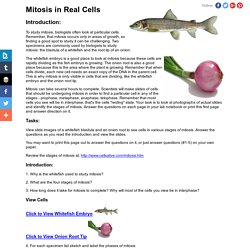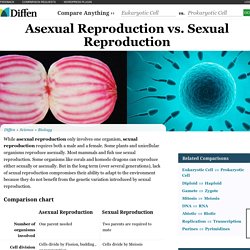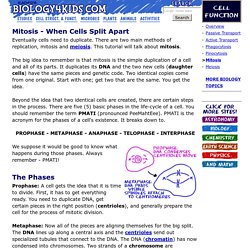

Mitosis in Real Cells. To study mitosis, biologists often look at particular cells.

Remember, that mitosis occurs only in areas of growth, so finding a good spot to study it can be challenging. Two specimens are commonly used by biologists to study mitosis: the blastula of a whitefish and the root tip of an onion. The whitefish embryo is a good place to look at mitosis because these cells are rapidly dividing as the fish embryo is growing.
The onion root is also a good place because this is the area where the plant is growing. Remember that when cells divide, each new cell needs an exact copy of the DNA in the parent cell. Mitosis can take several hours to complete. Tasks: View slide images of a whitefish blastula and an onion root to see cells in various stages of mitosis. You may want to print this page out to answer the questions on it, or just answer questions (#1-5) on your own paper. Video Clips for Biology! Lab 2—Mitosis Slides. Classroom Resources. Many say that our culture is obsessed with sex, and uses sexual references to sell everything from fragrances to cars.

And wouldn't life be dull without it? Yet from the viewpoint of evolutionary theory, sex isn't the most efficient way of reproducing. In fact, scientists have been asking for decades, why does sexual reproduction even exist? If the goal of life is spreading one's genes far and wide, asexually reproducing organisms seem to have the edge. They do not have to invest time and energy finding a mate. There are many hypotheses but, until recently, little hard evidence on the advantages of sex. One explanation is the increasingly popular Red Queen hypothesis, referring to the huffy chess piece in Lewis Carroll's Through the Looking Glass.
Scientists from Rutgers University in New Jersey have tested this idea by observing different groups of small fish called topminnow in Mexico. Meiosis with Crossing Over. Unit 3 Review - Mitosis and Meiosis. Evolution: Library: The Red Queen. Mitosis and Meiosis - Comparison Chart, Video and Pictures. Cells divide and reproduce in two ways: mitosis and meiosis.

Mitosis is a process of cell division that results in two genetically identical daughter cells developing from a single parent cell. Meiosis, on the other hand, is the division of a germ cell involving two fissions of the nucleus and giving rise to four gametes, or sex cells, each possessing half the number of chromosomes of the original cell. Mitosis is used by single-celled organisms to reproduce; it is also used for the organic growth of tissues, fibers, and membranes. Asexual Reproduction vs Sexual Reproduction - Difference and Comparison.
Moon Jellies has two main stages in its life cycle – polyp stage (asexual reproduction) & medusa stage (sexual reproduction) Types There are several different types of asexual reproduction.

These include budding, where the offspring grows out of the body of the parent, and gemmules, where the parent releases a specialized mass of cells that will become a new individual. Sexual Reproduction and Meiosis NOTES.pdf. Sexual vs. Asexual Reproduction. Cell Function: Meiosis. What are the big ideas here?

There are two cell divisions. Mitosis has one division and meiosis has two divisions. You still have to remember PMATI, but now you do it twice. You also need to remember that four cells are created where there was originally one. That's four (4) cells with half of the amount of DNA needed by a cell. Meiosis happens when it's time to reproduce an organism. As we said, meiosis happens when it's time to reproduce. That second division divides the number of chromosomes in half. Cell Function: Mitosis. Eventually cells need to duplicate.

Mitosis: An Interactive Animation. This animation demonstrates the stages of mitosis in an animal cell.

Use the control buttons along the bottom to run the complete animation. Click on any intermediate stage (for example, Anaphase), and see a representative still frame. Interphase: Cells may appear inactive during this stage, but they are quite the opposite. This is the longest period of the complete cell cycle during which DNA replicates, the centrioles divide, and proteins are actively produced. For a complete description of the events during Interphase, read about the Cell Cycle. Meiosis: An Interactive Animation. Diploid Cell (2N): From a preceding mitotic division, the Oogonium (Spermatogonium) enters meiosis with DIPLOID (2N) chromosomes but TETRAPLOID (4N) DNA.

Chromosomes then duplicate to produce SISTER CHROMATIDS (or HOMOLOGOUS DYADS). Prophase I: Dyad pairs align to create "TETRADS", non-sister chromatids connect and trade sections at a "CHIASMA", a process called "CROSSING OVER". Metaphase I: SPINDLE FIBERS attach to each dyad at the KINETOCHORE. Tension from spindle fibers aligns the tetrads at the cell equator. Anaphase I: Chiasmata break apart and sister chromatids begin migrating toward opposite poles. Animation: Comparison of Meiosis and Mitosis (Quiz 1) Genetics and Meiosis Games and Virtual Labs. Genetics and Meiosis Genes are passed on from one generation to the next!

Learn how this occurs through fun, interactive games and activities that explore genetics and meiosis! Genetics Video Games, Virtual Labs & Activities Snurfle Meiosis and Genetics 2: Diversity and Dihybrid Crosses When Snurfles reproduce, their offspring can have a lot of different traits (lots of diversity). Snurfle Meiosis and Genetics Snurfles, just like any other organism, must reproduce in order to continue as a species! Meiosis Battle Pong!! Fire comets at your opponent, dodge asteroids, and keep the ball in play in this fresh twist on the classic game of Pong, all while reviewing Meiosis! Mitosis and Meiosis: 'Interactive demonstrations' Mitosis and Meiosis.